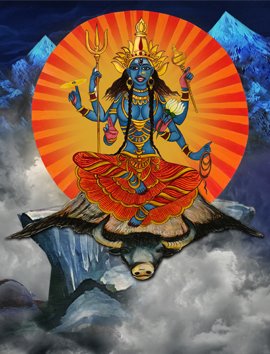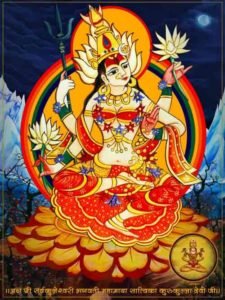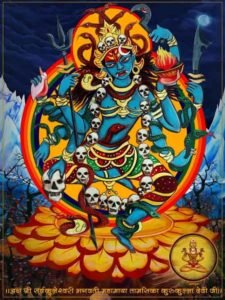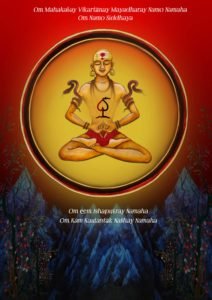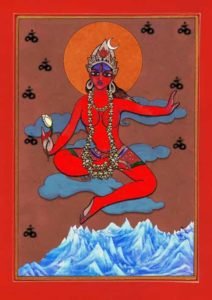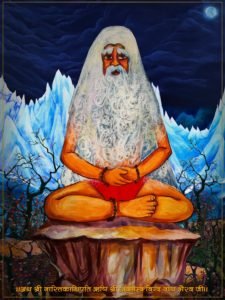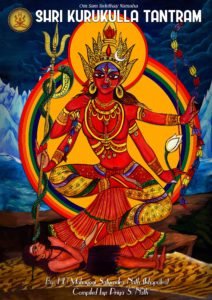Neel Vartali Devi (Sanskrit: नील वार्ताली), as per ‘Siddha Dharma’ is one of the four forms of goddess Vartali with Peet Vartali, Neel Vartali and Shyama Vartali. This form is also known as the dark blue form of the goddess. It is the ‘Nirguna form’ of the Vartali goddess.
The ‘Siddha Dharma’ affirms that the color of sky, the depth of the ocean is always blue under light and clear conditions. Even Lord Shiva is depicted as the god with bluish complexion because he is Trigunatmaka “within three modes of nature”, Trigunarahita “absence of the three modes of nature” and Nirguna “beyond the three modes of nature”. The Nirguna form is depicted by the dark blue color.
Etymology
Etymologically, the word नील वार्ताली is a Sanskrit word (नील वार्ताली = नील + वार्ताली), which when translated gives the results as the combination of the two words Neel and Vartali (नील + वार्ताली) which means ‘dark blue’ and ‘Vartali. So, ‘Neel Vartali’ is the dark blue form of Vartali goddess.
The ‘Siddha Dharma’ reveres the ‘Neel Vartali” goddess as a tantric deity. She is depicted as the goddess of ‘attraction’ and ‘mesmerization’. The ‘Siddha Dharma’ explains that the depth of the ocean is so deep that no person can reach the utmost depth because it is very deep. Even the sun’s rays do not penetrate to the bottom of the ocean. It is completely dark there. It is so deep and infinite that it can contain everything inside it. As per ‘Siddha Dharma’, her power of attraction can be explained by a simple example. When a pebble is thrown in the midst of the ocean, the pebbles keep on flowing down slowly and it takes numerous days/months to reach the bottom. From the perspective of the pebble, the ocean has attracted the pebbles so deep that it continuously flows down to reach the core.
But the most fundamental difference between the ocean and the Neel Vartali goddess is that, the ocean may be within boundaries but Neel Vartali goddess is ‘nirguna’ therefore she just keeps attracting something towards it to inifinty. Such ‘attraction powers’ can be cultivated by those sadhaka who perfects her. Out of every hundred person, eighty of them will feel attracted towards the sadhaka. Since she is also the goddess of attraction therefore she is also considered to be the goddess of love.
The ‘Siddha Dharma’ asserts that sadhana empowerment is recommended to be only received from a worthy guru with distinct guru/sishya lineage tradition. It is a waste of time if you try it on your own because empowerment or diksha means transfer of lineage power to the individual.
Iconography
The ‘Siddha Dharma’ depicts her as one of form among the four forms of Vartali goddess. Being a tantric deity, she is richly depicted in symbols and colors. She is depicted as sitting on the ‘Yak skin’ on a lotus position or padmasana, she is depicted as having dark blue complexion, beautiful and is also smiling with her lips not joined and her teeth lining can be seen.
The ‘Siddha Dharma’ also depicts her with two big round breasts which don’t signify lust but motherly affection. When she is pleased, she treats her worshipper like her own children and protects them. Her whole body is adorned with ornaments made of gold. She wears a big golden crown on her head and in its centre is the maroon jem. She also is depicted wearing a big heavy necklace and a big golden garland. She also wears golden bangles in both her wrist. Her hair is scattered and two pony tails separates and is seen in the front part of the body on either sides.
She is depicted as having four hands. She holds white lotus flower in one hand which signifies wisdoms while as in the another hand she is depicted as per ‘Siddha Dharma’ holding a trident which signifies her as the goddess of warriors. Her hand also holds a golden mace which signifies her to subjugate. She also holds a hook in her hand which signifies her power to trap anyone with her hook and keep the person enchanted and mesmerized. The Kaulantak Peeth has her own depiction and as per its own guru/sishya lineage. No images of Vartali are in public domain to the best of the knowledge of ‘Siddha Dharma’.
Modes of Worship
The Kaulantak Peeth tradition and the ‘Siddha Dharma’ primarily believe in the guru/sishya lineage because this helps to keep the knowledge free of any fallacies or arbitration. Since, the knowledge of goddess Vartali has passed down many generations from Lord Shiva to His Holiness, the ‘Siddha Dharma’ believes that to protect the sanctity of the sadhana, only guru/sishya lineage prescribed methods should be adopted and other methods be shunned.
The ‘Siddha Dharma’ prescribes many methods of her sadhana and worship methods from Yoga to pure Tantra. She is primarily a tantric deity, so the Peeth mainly prescribes the tantric methods but the Peeth is also eligible to impart it through the mode of Yoga because His Holiness Kaulantak Peethadhishwara “Mahayogi Satyendra Nath Ji Maharaj” (Ishaputra) is also adept in Yoga.
As mentioned before, Vartali goddess is the goddess of flowers. She loves flowers. She is very pleased by flowers. As per ‘Siddha Dharma’ the tantric pleases her through the offerings of various flowers. Her sadhana is to be done in solitude or in the midst of nature.
Besides that, the ‘Siddha Dharma’ can initiate a sadhaka into the sadhana path of Neel Vartali from the below given methods and procedures. The decision shall rest upon His Holiness Kaulantak Peethadhishwara “Mahayogi Satyendra Nath Ji Maharaj” (Ishaputra) to initiate and impart the teachings to any sadhaka based on his own discretion. The methods and procedures are:
- Kaulachara
- Vedachara
- Mrikulachara
- Tantrokta
- Akulachara
- Mishrachara
- Sastrokta
- Aghorachara
- Vamachara
- Chinachara
- Samayachara
- Yoga Parampara
‘Siddha Dharma’ can also initiate the sadhaka through Yoga procedures. The Yoga procedure is all about using dharana/visualization to achieve the required perfection. The dharana procedure is only given through guru/sishya tradition and cannot be revealed in public as it is against the norms of the ‘Siddha Dharma’
Yantra
Yantra is the physical representation of any deity in geometrical form. The ‘Siddha Dharma’ uses geometric diagrams, words, syllable, symbols to manipulate the consciousness, so as it can be directed in a certain way to create an idea in the mind. Without Yantra, the tantric ritual of Neel Vartali goddess is impossible. Yantra is the most important part of any tantric ritual.
As per ‘Siddha Dharma’, the ‘Neel Vartali’ yantra uses triangles, circles and bhupura to create the Yantra.
Mantra
The ‘Kaulantak Peeth’ tradition of the siddha’s has numerous mantras of the goddess. The mantras of the goddess are also as per the modes of their worship. The mantra of Aghorachara is different than Misracharya, Kaulacharya with Akulacharya etc. Furthermore, the Peeth also recommends ‘Shabar Mantra’ for the sadhana procedure as it is very easy to comprehend and is understandable.
There might be lot of schools or modes of worship of the goddess but the Peeth and ‘Siddha Dharma’ prescribes four mantras for each deity for each mode of worship or kulas. For instance, a Aghora panth will prescribe four mantras for the “Neel Vartali”. The four mantras represent four modes of nature. The four modes of nature or the gunas according to which the mantras corresponds are satwa, raja, tama and nirguna. The Peeth while imparting the diksha and mantra gives four mantras of a deity which is the satwa, raja, tama and nirguna mantra.
Scripture, Texts and eligibility
The Peeth and the ‘Siddha Dharma’ tradition have a special book called “Vartali devi sutram” which is maintained as in the form of oral tradition. The Guru gives the knowledge of the book through oral tradition.
“Vartali Devi Sutram” prescribes methods and percepts that one can cultivate in the daily habits of any individual so as to develop oneself. It prescribes short methods and standards to follow. It also mentions the fact that “Neel Vartali” is the goddess of calm demeanor, so everyone is eligible to participate in her sadhana.
The Kaulantak Peeth is the Peeth of “veer bhava”, the ‘hero mentality”. So the goddess doesn’t believe in shortcuts. The ‘Siddha Dharma’ believes that to perfect her, strict discipline and perseverance is the key. When she is perfected, it is believed nothing lefts to be perfected.

